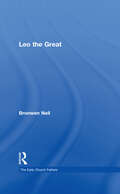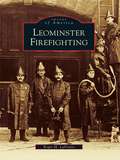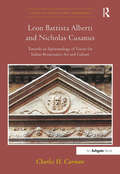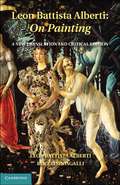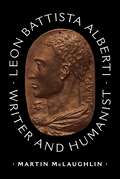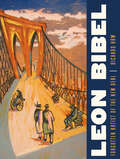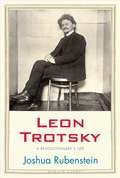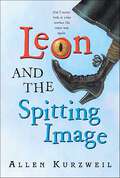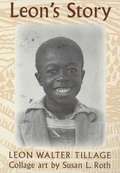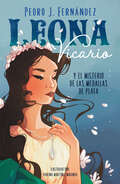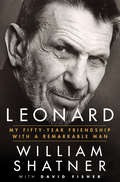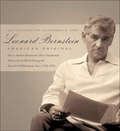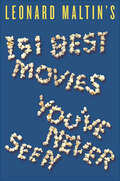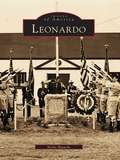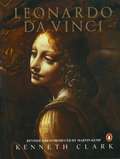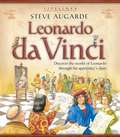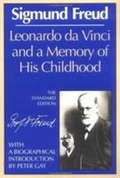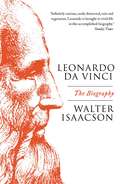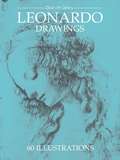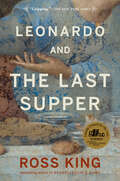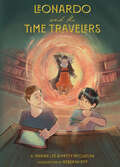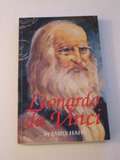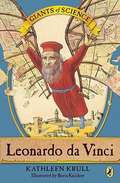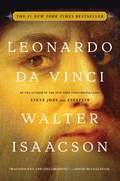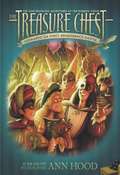- Table View
- List View
Leo the Great (The Early Church Fathers)
by Bronwen NeilPope Leo I’s theological and political influence in his own time (440-461) and beyond far outweighs the amount of attention he has received in recent scholarship. That influence extended well beyond Rome to the Christian East through his contribution to preparations for the Council of Chalcedon and its outcome. For this he was alternately praised and vilified by the opposing parties at the Council. Leo made his views known through letters, and a vast number of homilies. While so many of these survive, Leo and his works have not been the subject of a major English-language socio-historical study in over fifty years. In this brief introduction to the life and works of this important leader of the early church, we gain a more accurate picture of the circumstances and pressures which were brought to bear on his pontificate. A brief introduction surveys the scanty sources which document Leo’s early life, and sets his pontificate in its historical context, as the Western Roman Empire went into serious decline, and Rome lost its former status as the western capital. Annotated translations of various excerpts of Leo’s letters and homilies are organised around four themes dealing with specific aspects of Leo’s activity as bishop of Rome: Leo as spiritual adviser on the life of the faithful Leo as opponent of heresy the bishop of Rome as civic and ecclesiastical administrator Leo and the primacy of Rome. Taking each of these key elements of Leo’s pontifical activities into account, we gain a more balanced picture of the context and contribution of his best-known writings on Christology. This volume offers an affordable introduction to the subject for both teachers and students of ancient and medieval Christianity.
Leominster Firefighting (Images of America)
by Roger H. LapointeIn 1820, a group of Leominster volunteers formed Engine Company No. 1 "in the interests of protecting the rights of the settlers in case of fire." Since then, more than 1,400 individuals have served as firefighters for the citizens of Leominster, each of them leaving behind a legacy that will never be forgotten. Leominster Firefighting features images, memorabilia, and photographs from the early days of the hand tubs and horse-drawn hose carts of the 1800s to the 20th century when motorized apparatus arrived. It provides a glimpse into the many traditions that have been passed from one generation to the next and a look into how fire has changed Leominster.
Leon Battista Alberti and Nicholas Cusanus: Towards an Epistemology of Vision for Italian Renaissance Art and Culture (Visual Culture in Early Modernity)
by Charles H. CarmanProviding a fresh evaluation of Alberti’s text On Painting (1435), along with comparisons to various works of Nicholas Cusanus - particularly his Vision of God (1450) - this study reveals a shared epistemology of vision. And, the author argues, it is one that reflects a more deeply Christian Neoplatonic ideal than is typically accorded Alberti. Whether regarding his purpose in teaching the use of a geometric single point perspective system, or more broadly in rendering forms naturalistically, the emphasis leans toward the ideal of Renaissance art as highly rational. There remains the impression that the principle aim of the painter is to create objective, even illusionistic images. A close reading of Alberti’s text, however, including some adjustments in translation, points rather towards an emphasis on discerning the spiritual in the material. Alberti’s use of the tropes Minerva and Narcissus, for example, indicates the opposing characteristics of wisdom and sense certainty that function dialectically to foster the traditional importance of seeing with the eye of the intellect rather than merely with physical eyes. In this sense these figures also set the context for his, and, as the author explains, Brunelleschi’s earlier invention of this perspective system that posits not so much an objective seeing as an opposition of finite and infinite seeing, which, moreover, approximates Cusanus’s famous notion of a coincidence of opposites. Together with Alberti’s and Cusanus’s ideals of vision, extensive analysis of art works discloses a ubiquitous commitment to stimulating an intellectual perception of divine, essential, and unseen realities that enliven the visible material world.
Leon Battista Alberti: On Painting
by Rocco Sinisgalli Leon Battista AlbertiLeon Battista Alberti was one of the most important humanist scholars of the Italian Renaissance. Active in mid-fifteenth-century Florence, he was an architect, theorist, and author of texts on perspective and painting. Leon Battista Alberti: On Painting is a cardinal work that revolutionized Western art. In this volume, Rocco Sinisgalli presents a new English translation and critical examination of Alberti's seminal text. Dr Sinisgalli reverses the received understanding of the relationship between the Italian and Latin versions of Alberti's treatise by demonstrating that Alberti wrote it first in Italian and then translated it into a polished Latin over the course of several decades. This volume is richly illustrated to help demonstrate how Alberti understood optics and art.
Leon Battista Alberti: Writer and Humanist
by Martin McLaughlinThe first book in English to examine Leon Battista Alberti&’s major literary works in Latin and Italian, which are often overshadowed by his achievements in architectureLeon Battista Alberti (1404–1472) was one of the most prolific and original writers of the Italian Renaissance—a fact often eclipsed by his more celebrated achievements as an art theorist and architect, and by Jacob Burckhardt&’s mythologizing of Alberti as a "Renaissance or Universal Man." In this book, Martin McLaughlin counters this partial perspective on Alberti, considering him more broadly as a writer dedicated to literature and humanism, a major protagonist and experimentalist in the literary scene of early Renaissance Italy. McLaughlin, a noted authority on Alberti, examines all of Alberti&’s major works in Latin and the Italian vernacular and analyzes his vast knowledge of classical texts and culture.McLaughlin begins with what we know of Alberti&’s life, comparing the facts laid out in Alberti&’s autobiography with the myth created in the nineteenth century by Burckhardt, before moving on to his extraordinarily wide knowledge of classical texts. He then turns to Alberti&’s works, tracing his development as a writer through texts that range from an early comedy in Latin successfully passed off as the work of a fictitious ancient author to later philosophical dialogues written in the Italian vernacular (a revolutionary choice at the time); humorous works in Latin, including the first novel in that language since antiquity; and the famous treatises on painting and architecture. McLaughlin also examines the astonishing range of Alberti's ancient sources and how this reading influenced his writing; what the humanist read, he argues, often explains what he wrote, and what he wrote reflected his relentless industry and pursuit of originality.
Leon Bibel: Forgotten Artist of the New Deal
by Richard HawLeon Bibel (1913–1995) was a prolific modern American artist who painted, printed, stamped, etched, sketched, and carved. He produced pieces that ranged from social realism to dreamy expressionism and was an aesthetic experimentalist, never working for too long in any medium or style. And despite Bibel's obvious talent, his work would have languished in obscurity were it not for the New Deal programs like the Federal Art Project and Public Works of Art Project. Leon Bibel, the first biography of this eclectic artist, recounts his life from his birth in Szczebrzeszyn, Poland, in 1913, to his death in New Jersey in 1995. After immigrating to the United States in the 1920s, Bibel came of age during the Great Depression, when New Deal agencies recognized his abilities and supported his artistic endeavors. Working-class artists faced challenges after these programs folded, and Bibel would later spend twenty years as a New Jersey chicken farmer before resurrecting his art career in the 1960s. Historian Richard Haw shows how Bibel's life was defined by the New Deal, his visionary artwork shaped by the era's commitment to social and economic justice. With reproductions of more than 240 of Bibel's works, most in vivid color, this book reveals how he depicted everything from the trauma of unemployment to the dignity of work, from the horrors of lynching to the pleasures of everyday life.
Leon Trotsky: A Revolutionary's Life
by Joshua RubensteinBorn Lev Davidovich Bronstein in southern Ukraine, Trotsky was both a world-class intellectual and a man capable of the most narrow-minded ideological dogmatism. He was an effective military strategist and an adept diplomat, who staked the fate of the Bolshevik revolution on the meager foundation of a Europe-wide Communist upheaval. He was a master politician who played his cards badly in the momentous struggle for power against Stalin in the 1920s. And he was an assimilated, indifferent Jew who was among the first to foresee that Hitler's triumph would mean disaster for his fellow European Jews, and that Stalin would attempt to forge an alliance with Hitler if Soviet overtures to the Western democracies failed. Here, Trotsky emerges as a brilliant and brilliantly flawed man. Rubenstein offers us a Trotsky who is mentally acute and impatient with others, one of the finest students of contemporary politics who refused to engage in the nitty-gritty of party organization in the 1920s, when Stalin was maneuvering, inexorably, toward Trotsky's own political oblivion. As Joshua Rubenstein writes in his preface, "Leon Trotsky haunts our historical memory. A preeminent revolutionary figure and a masterful writer, Trotsky led an upheaval that helped to define the contours of twentieth-century politics. " In this lucid and judicious evocation of Trotsky's life, Joshua Rubenstein gives us an interpretation for the twenty-first century.
Leon and the Spitting Image
by Allen KurzweilThis book is about a hotel full of animals. And an evil ice maker. And glass eyeballs -- oh, and really old panty hose and Possibly Fake Hair. But mostly, it's about Leon Zeisel and his epic quest to survive fourth grade, despite his teacher, Miss Hagmeyer, and his archenemy, Lumpkin the Pumpkin, a human tank with a deadly dodgeball throw. Luckily, Leon has friends who will stand by him even if his magical plans for rescue and revenge involve ... SPIT!
Leon's Story
by Leon Walter TillageThe son of a North Carolina sharecropper recalls the hard times faced by his family and other African Americans in the first half of the 20th century, and the changes that the civil rights movement helped bring about.
Leona Vicario y el misterio de las medallas de plata
by Pedro J. FernándezUna novela de suspenso histórico para niños en la que conoceremos las aventuras de Leona Vicario, espía independentista. Nueva España, 1810. Después de que una mujer desconocida le regalara una medalla de plata en el mercado, Leona Vicario comienza a recibir crípticos mensajes de un remitente desconocido, que la cita en el Templo de la Profesa. Pronto el misterio se hace todavía más grande: ¿quiénes son Los Guadalupes?, ¿qué quieren de ella?, ¿cómo saber quién apoya la independencia y quién es leal al virrey? Abriendo la puerta a una aventura que la llevará por todos los rincones de la capital, Leona emprende una carrera contra el reloj para luchar por el sueño de ver a México como un país libre. Convertida en una espía contra el virreinato, ¿cuál será el precio que tendrá que pagar por su silencio?
Leonard
by William Shatner David FisherLeonard Nimoy and William Shatner first crossed paths as actors on the set of The Man from U.N.C.L.E. Little did they know that their next roles, in a new science fiction television series, would shape their lives in ways no one could have anticipated. In seventy-nine television episodes and six feature films, they grew to know each other more than most friends could ever imagine. Over the course of half a century, Shatner and Nimoy saw each other through personal and professional highs and lows. In this powerfully emotional book, Shatner tells the story of a man who was his friend for five decades, recounting anecdotes and untold stories of their lives on and off set, as well as gathering stories from others who knew Nimoy well, to present a full picture of a rich life. As much a biography of Nimoy as a story of their friendship, Leonard is a uniquely heartfelt book written by one legendary actor in celebration of another.
Leonard Bernstein: American Original
by Barbara Haws Burton BernsteinOne of the most gifted, celebrated, scrutinized, and criticized musicians in the second half of the twentieth century, Leonard Bernstein made his legendary conducting debut at the New York Philharmonic in 1943, at age 25. A year later, he became a sensation on Broadway with the premiere of On the Town. Throughout the 1950s, his Broadway fame only grew with Wonderful Town, Candide, and West Side Story. And in 1958, the Philharmonic appointed him the first American Music Director of a major symphony orchestra—a signal historical event. He was adored as a quintessential celebrity but one who could do it all—embracing both popular and classical music, a natural with the new medium of television, a born teacher, writer, and speaker, as well as a political and social activist. In 1976, having conducted the Philharmonic for more than one thousand concerts, he took his orchestra on tour to Europe for the last time.All of this played out against the backdrop of post-Second World War New York City as it rose to become the cultural capital of the world—the center of wealth, entertainment, communications, and art—and continued through the chaotic and galvanizing movements of the 1960s that led to its precipitous decline by the mid 1970s. The essays within this book do not simply retell the Bernstein story; instead, Leonard Bernstein's brother, Burton Bernstein, and current New York Philharmonic archivist and historian, Barbara B. Haws, have brought together a distinguished group of contributors to examine Leonard Bernstein's historic relationship with New York City and its celebrated orchestra. Composer John Adams, American historians Paul Boyer and Jonathan Rosenberg, music historians James Keller and Joseph Horowitz, conductor and radio commentator Bill McGlaughlin, musicologist Carol Oja, and music critics Tim Page and Alan Rich have written incisive essays, which are enhanced by personal reminiscences from Burton Bernstein. The result is a telling portrait of Leonard Bernstein, the musician and the man.
Leonard Maltin's 151 Best Movies You've Never Seen
by Leonard MaltinWhat 151 movies have you never seen—but should?What French film could teach Hollywood how to make a smart, sexy romantic comedy? (page 233)Where will you find a female-centric Western with a gender-bending protagonist? (page 10)What film won a Special Jury Prize at Sundance and then fell off the radar? (page 261)What farcical comedy includes such real-life characters as Richard Nixon and Henry Kissinger? (page 50)In what unsung comedy will you find Michael Douglas giving his all-time best performance? (page 130)What debut film from the director of The Dark Knight creates palpable chills—despite a shoestring budget and a no-name cast? (page 79)What John Wayne movie was out of circulation for thirty years—and still qualifies as a sleeper? (page 121)What terrific Heath Ledger movie was released the same month as Brokeback Mountain—and flopped? (page 26)What clever modern-day film noir was made for just half a million dollars? (page 18)What captivating film stars one of the seminal artists of the twentieth century? (page 203)
Leonardo
by Holly BianchiLeonardo, one of Monmouth County's most picturesque seaside resorts, is portrayed in images that will fill the heart and lift the spirit. With some two hundred vintage photographs, Leonardo offers an overview of this beautiful beach town, which lies on the banks of the Sandy Hook Bay in central New Jersey. A tightly knit and friendly community, Leonardo has long been recognized as a haven for artists and writers. The town's sandy beaches and intriguing maritime history attract thousands of visitors every year.With a collection of early-twentieth-century to the recent past photographs and informative historical information, Leonardo explores the many features of a town that has become known as the "jewel in the crown." This history features images of Leonardo's celebrated sculptor and artist Donald DeLue, who created the sculpture The Rocket Thrower for the 1964-1965 New York World's Fair. Also seen are photographs of the Leonardo State Marina and the famous Conover Beacon Lighthouse. The historic Applegate Cemetery, where the legendary Mary Stillwell Applegate is buried, is pictured along with a description of its folklore tale.
Leonardo Da Vinci
by Kenneth Clark Martin KempA personally compelling introduction to Leonardo's genius, a classic monograph of Leonardo's art and his development.
Leonardo Da Vinci
by Steve AugardeThis illustrated biography series combines non-fiction and fiction to introduce readers to famous historical characters. Each book begins with a diary, told from the point of view of a child who works for the famous person. At the end of each book there is an illustrated reference chapter.
Leonardo Da Vinci and a Memory of His Childhood
by Sigmund FreudA detailed reconstruction of Leonardo's emotional life from his earliest years, it represents Freud's first sustained venture into biography from a psychoanalytic perspective, and also his effort to trace one route that homosexual development can take.
Leonardo Da Vinci: Cong Fan Ren Dao Tian Cai De Chuang Zao Li Mi Ma = Leonardo Da Vinci
by Walter Isaacson'To read this magnificent biography of Leonardo da Vinci is to take a tour through the life and works of one of the most extraordinary human beings of all time in the company of the most engaging, informed, and insightful guide imaginable. Walter Isaacson is at once a true scholar and a spellbinding writer. And what a wealth of lessons there are to be learned in these pages.' David McCullough Based on thousands of pages from Leonardo&’s astonishing notebooks and new discoveries about his life and work, Walter Isaacson weaves a narrative that connects his art to his science. He shows how Leonardo&’s genius was based on skills we can improve in ourselves, such as passionate curiosity, careful observation, and an imagination so playful that it flirted with fantasy. He produced the two most famous paintings in history, The Last Supper and the Mona Lisa. But in his own mind, he was just as much a man of science and technology. With a passion that sometimes became obsessive, he pursued innovative studies of anatomy, fossils, birds, the heart, flying machines, botany, geology, and weaponry. His ability to stand at the crossroads of the humanities and the sciences, made iconic by his drawing of Vitruvian Man, made him history&’s most creative genius. His creativity, like that of other great innovators, came from having wide-ranging passions. He peeled flesh off the faces of cadavers, drew the muscles that move the lips, and then painted history&’s most memorable smile. He explored the math of optics, showed how light rays strike the cornea, and produced illusions of changing perspectives in The Last Supper. Isaacson also describes how Leonardo&’s lifelong enthusiasm for staging theatrical productions informed his paintings and inventions. Leonardo&’s delight at combining diverse passions remains the ultimate recipe for creativity. So, too, does his ease at being a bit of a misfit: illegitimate, gay, vegetarian, left-handed, easily distracted, and at times heretical. His life should remind us of the importance of instilling, both in ourselves and our children, not just received knowledge but a willingness to question it—to be imaginative and, like talented misfits and rebels in any era, to think different.
Leonardo Drawings: Sketches & Drawings (Dover Fine Art, History of Art)
by Leonardo Da VinciAlthough Leonardo da Vinci was one of the greatest artists who ever lived, his career was marked by an unusually large number of uncompleted projects and by finished works that rapidly deteriorated. Nevertheless, his influence is undoubted, and his claim to greatness rests chiefly on his drawings, which have been carefully preserved in such locations as Windsor Castle, the Louvre, the Uffizi Gallery, and the British Museum.This collection, excellently reproduced in black-and-white, is representative of Leonardo's various achievements in many drawing media. Among the selections are drawings of plants, landscapes, animals, battles, weapons, and the human face and figure, as well as studies for later paintings or sculpture: a full compositional study for The Adoration of the Magi, a study for the angel's head in The Virgin of the Rocks, studies of horses for the Sforza monument, studies for The Last Supper, studies for The Battle of Anghiari, and an early cartoon for The Madonna with St. Anne.
Leonardo and the Last Supper
by Ross KingLeonardo da Vinci's transcendent painting The Last Supper defined the master artist. Until now, no one has told the full story behind its creation. Political events weighed on da Vinci and all of Italy during the time of the painting's conception and creation, as his patron, the Duke of Sforza, unleashed forces leading to a decades-long series of tragedies known as the Italian Wars. Sforza was overthrown by French forces in 1499, forcing da Vinci to flee Milan with the paint on The Last Supper barely dry. The Last Supper ensured Leonardo's universal renown as a visionary master of the arts.
Leonardo and the Time Travelers
by Marian Lye, Patty McGuigan, Illustrated by Rebekah ReifWHAT WOULD YOU DO... if a time traveler landed on your doorstep? In Leonardo and the Time Travelers, Jack and Nick are in Silicon Valley for a summer technology class, when they discover a secret time travel app. They bring back the world's first time traveler, Leonardo da Vinci, and adventure ensues! Joined by Jack's sister Poppy, they solve problems, meet other time travelers, and have a summer they will never forget.
Leonardo da Vinci
by Emily HahnLeonardo's interests and achievements spread far beyond the world of art. He studied astronomy, botany, anatomy, and geology, and designed and drew plans for hundreds of inventions, many of which fore-shadowed the achievements of men who lived four hundred years after Leonardo died. Emily Hahn brings this quintessential Renaissance Man to life in her delightful and easy to read biography.
Leonardo da Vinci
by Kathleen KrullLeonardo da Vinci's notebooks are mind-boggling evidence of a fifteenth-century scientific genius standing at the edge of the modern world, basing his ideas on observation and experimentation. This book will change children's ideas of who Leonardo was and what it means to be a scientist. .
Leonardo da Vinci
by Walter Isaacson<P>He was history’s most creative genius. What secrets can he teach us? The author of the acclaimed bestsellers Steve Jobs, Einstein, and Benjamin Franklin brings Leonardo da Vinci to life in this exciting new biography. <P>Based on thousands of pages from Leonardo’s astonishing notebooks and new discoveries about his life and work, Walter Isaacson weaves a narrative that connects his art to his science. He shows how Leonardo’s genius was based on skills we can improve in ourselves, such as passionate curiosity, careful observation, and an imagination so playful that it flirted with fantasy. He produced the two most famous paintings in history, The Last Supper and the Mona Lisa. But in his own mind, he was just as much a man of science and technology. <P>With a passion that sometimes became obsessive, he pursued innovative studies of anatomy, fossils, birds, the heart, flying machines, botany, geology, and weaponry. His ability to stand at the crossroads of the humanities and the sciences, made iconic by his drawing of Vitruvian Man, made him history’s most creative genius. His creativity, like that of other great innovators, came from having wide-ranging passions. He peeled flesh off the faces of cadavers, drew the muscles that move the lips, and then painted history’s most memorable smile. He explored the math of optics, showed how light rays strike the cornea, and produced illusions of changing perspectives in The Last Supper. <P>Isaacson also describes how Leonardo’s lifelong enthusiasm for staging theatrical productions informed his paintings and inventions. Leonardo’s delight at combining diverse passions remains the ultimate recipe for creativity. So, too, does his ease at being a bit of a misfit: illegitimate, gay, vegetarian, left-handed, easily distracted, and at times heretical. His life should remind us of the importance of instilling, both in ourselves and our children, not just received knowledge but a willingness to question it—to be imaginative and, like talented misfits and rebels in any era, to think different. <P><b>A New York Times Bestseller</b>
Leonardo da Vinci #9
by Ann Hood Denis ZilberTravel back in time to Renaissance Italy with the Robbins twins! In book nine of The Treasure Chest, Maisie and Felix continue to learn the magic of Elm Medona and the Pickworth family history. In the latest adventure, the twins travel to fifteenth- century Italy and meet a young Leonardo da Vinci. Every Treasure Chest book features a biography of the featured historical figure along with Ann's Favorite Facts from her research!
